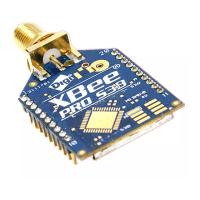Sleep modes Sleeping routers
XBee®-PRO 900HP/XSC RF Modules
61
Auto-early wake-up sleep option
If you have nodes that are missing sync messages and could be going out of sync with the rest of the
network, enabling an early wake gives the device a better chance to hear the sync messages that are
being broadcast.
Similar to the sleep guard time, the auto early wake-up option decreases the sleep period based on
the number of sync messages a node misses. This option comes at the expense of battery life.
Use the SO command to disable auto-early wake-up sleep. This option is enabled by default.
Select sleep parameters
Choosing proper sleep parameters is vital to creating a robust sleep-enabled network with a desirable
battery life. To select sleep parameters that will be good for most applications, follow these steps:
1. Choose NN and NH.
Based on the placement of the nodes in your network, select the appropriate values for
the NH (Network Hops) and NN (Network Delay Slots) parameters.
We optimize the default values of NH and NN to work for the majority of deployments.
In most cases, we suggest that you do not modify these parameters from their default
values. Decreasing these parameters for small networks can improve battery life, but
take care to not make the values too small.
2. Calculate the Sync Message Propagation Time (SMPT).
This is the maximum amount of time it takes for a sleep synchronization message to
propagate to every node in the network. You can estimate this number with the
following formula:
SMPT = NN*NH*(MT+1)*18 ms.
3. Select the duty cycle you want.
The ratio of sleep time to wake time is the factor that has the greatest effect on the device’s
power consumption. Battery life can be estimated based on the following factors:
n sleep period
n wake time
n sleep current
n RX current
n TX current
n battery capacity
4. Choose the sleep period and wake time.
The wake time must be long enough to transmit the desired data as well as the sync message.
The ST parameter automatically adjusts upwards to its minimum value when you change other
AT commands that affect it (SP, NN, and NH).
Use a value larger than this minimum. If a device misses successive sync messages, it reduces
its available transmit time to compensate for possible clock drift. Budget a large enough ST
time to allow for the device to miss a few sync messages and still have time for normal data
transmissions.
Start a sleeping synchronous network
By default, all new nodes operate in normal (non-sleep) mode. To start a synchronous sleeping
network, follow these steps:

